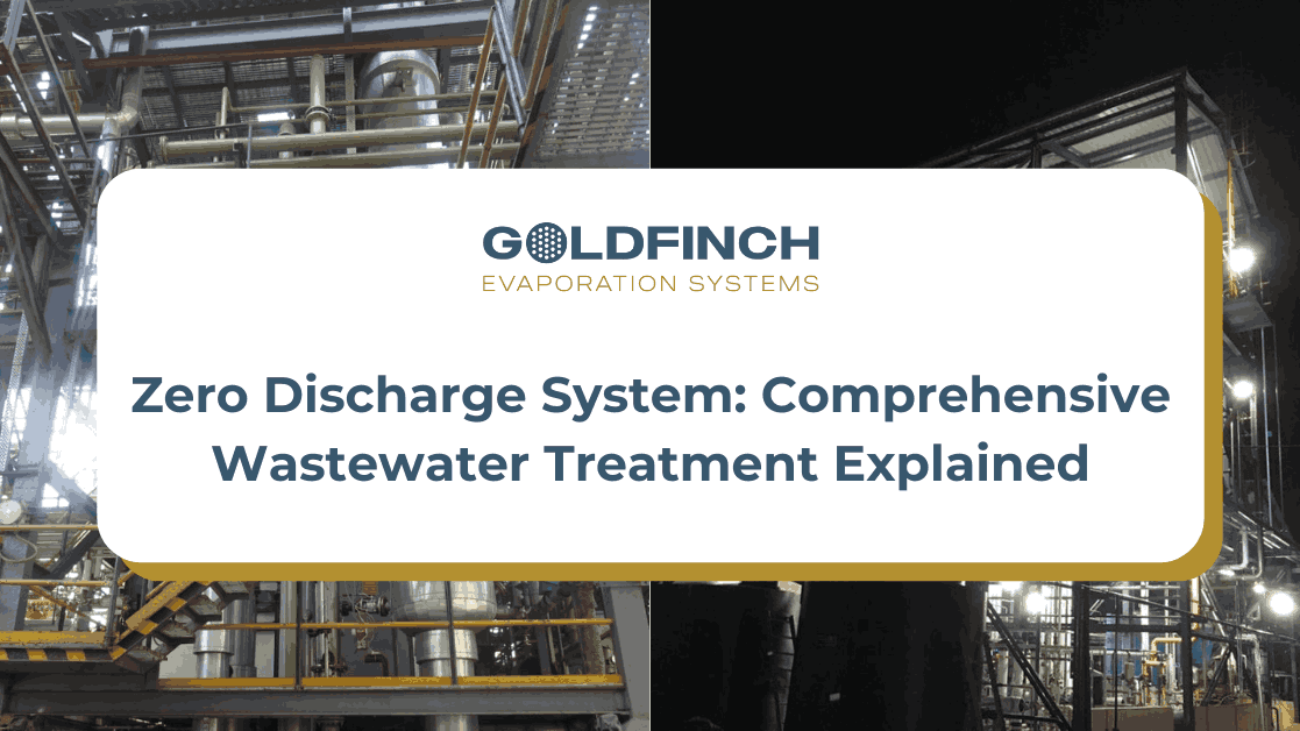Understanding Zero Discharge System’s Concepts and Principles
The zero discharge system is a treatment alternative that treats wastewater in such a manner to avoid any liquid discharge from industrial or municipal operations. The main goal remains recycling the water for use and sustainable waste disposal. The same approach supports environmental regulation while minimizing the ecological footprint.
The principle of ZDS defines and integrates physical, chemical, and thermal processes in wastewater treatment, resource recovery, and environment-friendly liquid disposal.
The primary components of a zero-discharge system include
A well-designed ZDS comprises several critical components:
- Pretreatment: It is a unit operation involving the removal of large solids and hazardous substances from the incoming wastewater.
- Evaporation system: Thermal proceedings through which water is separated from the impure stream.
- Evaporation Systems: Utilize thermal processes to separate water from contaminants.
- Crystallizers: Further concentrate waste and recover valuable salts.
- Membrane concepts: Membrane technologies, including reverse osmosis (RO) and electrodialysis, provide effective filtration.
- Waste Management Unit: Handles solid residues safely and sustainably.
Operational Process of Zero Discharge System
- Wastewater Collection: Water is gathered from industrial or municipal sources.
- Pre-Treatment: Filtration and chemical treatments remove large particles while neutralizing hazardous substances.
- Advanced Filtration: Membrane processes such as RO remove dissolved salts.
- Evaporation and Crystallization: Evaporate water and crystallize solids for their easy disposal.
- Water Recovery: Reclaims treated water for reuse in processing.
Benefits of Zero Discharge System
Environmental Benefits
- Pollution abatement: It prevents hazardous liquid waste from entering the natural water bodies.
- Resource recovery: It makes the recovery of useful resources, such as salts and minerals, feasible.
- Water conservation: Water reuse and conservation result in lesser demand for fresh water.
Economic Aspects
Cost efficiency: It reduces expenses associated with wastewater disposal and procurement of fresh water.
Compliance Credits: It assists industries in complying with stringent environmental regulations while avoiding penalties.
Operational Efficiency: is concerned with enhanced productivity through resource optimization.
Challenges and a Few Possible Solutions to Implement a Zero Discharge System.
Technical challenges
- Complexity of Design: Requires expertise in system design and engineering.
- Maintenance Needs: High maintenance due to sophisticated components.
- Solution: Investing in robust system design and automated monitoring technologies.
Economic Challenges
- High Initial Investment: The cost of installation and equipment can be significant.
- Solution: Long-term savings and government incentives can offset initial expenses.
Confronting Legal Hurdles
- Requirements for Compliance: Having to deal with environmental regulations can be a daunting task.
- Solution: Going for support in this area from regulatory-compliance specialists.
Applications of Zero Discharge System
Industrial Applications
- Chemical Manufacturing: Efficient handling of hazardous effluents.
- Textile Industry: Water reuse in dyeing and processing.
- Power Plants: Treatment and recovery of cooling tower blowdown water.
Municipal Applications
- Urban Wastewater Treatment: Water recycling is assured for non-potable uses in so-called safe modes.
- The sludge management plan envisions a techno-economically sound and, above all, efficient disposal of solids.
How would you define Zero Liquid Discharge (ZLD)?
ZLD is an advanced mechanism of treatment of wastewater towards maximum recovery and reuse of water from industrial waste.
ZLD – The Advanced Water Treatment Process
Zero Liquid Discharge is one of the great processes involving ultrafiltration, reverse osmosis, and thermal evaporation that ensures zero liquid discharge.
The Goldfinch Zero Liquid Discharge System
Goldfinch is a leader in providing cutting-edge Zero Liquid Discharge Systems in India. With over four decades of expertise, Goldfinch specializes in innovative evaporator and vapor recompression solutions for industrial applications.
Benefits of ZLD Plant
- Complete Water Recovery: Achieves maximum water reuse.
- Resource Efficiency: Recovers valuable by-products.
- Environmental Compliance: Ensures adherence to environmental regulations.
ZLD System by MEGA (RALEX® ED(R)-IF)
- The World’s Most Capable Electrodialysis: Ideal for industrial applications.
- Advantages: Efficient brine treatment and resource recovery.
Advantages coming with RO Brine Treatment with MEGA ZLD System
- Efficient Filtration: Removes high concentrations of salts and impurities.
- Cost-Effective: Reduces operational costs through advanced technology.
Our ZLD Projects
Goldfinch has successfully implemented numerous ZLD projects across various industries, setting benchmarks for sustainable wastewater treatment.
Explore Our Compact Range of Zero Discharge Systems
Goldfinch offers a compact and efficient range of Zero Discharge Systems in various designs to meet industry-specific requirements.
Conclusion
So, it is a very innovative approach that has economic, environmental, and operational benefits in the field of wastewater treatment. With the investment in the ZDS, industry and municipalities can ensure a sustainable future for themselves and their community while complying with environmental regulations. Goldfinch, having laid down its expertise on the subject, is still at the forefront of providing innovative solutions in zero liquid discharge and sustainable water management.


